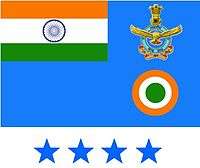Edgar Ludlow-Hewitt
| Sir Edgar Ludlow-Hewitt | |
|---|---|
|
Air Chief Marshal Ludlow-Hewitt | |
| Born | 9 June 1886 |
| Died | 15 August 1973 (aged 87) |
| Allegiance | United Kingdom |
| Service/branch |
British Army (1905–18) Royal Air Force (1918–45) |
| Years of service | 1905–45 |
| Rank | Air Chief Marshal |
| Commands held |
Inspector-General of the RAF (1940–45) Bomber Command (1937–40) RAF India (1935–37) Iraq Command (1930–32) RAF Staff College (1926–30) 3rd (Corps) Wing (1916–17) No. 3 Squadron (1915–16) No. 15 Squadron (1915) |
| Battles/wars |
First World War Second World War |
| Awards |
Knight Grand Cross of the Order of the Bath Knight Grand Cross of the Order of the British Empire Companion of the Order of St Michael and St George Distinguished Service Order Military Cross Mentioned in Despatches (6) Knight of the Legion of Honour (France) |
Air Chief Marshal Sir Edgar Rainey Ludlow-Hewitt, GCB, GBE, CMG, DSO, MC, DL (9 June 1886 – 15 August 1973) was a senior Royal Air Force commander.
First World War
Ludlow-Hewitt was commissioned into the Royal Irish Rifles in 1905 but transferred to the Royal Flying Corps (RFC) before the First World War, where he qualified for the Royal Aero Club's Aviator's Certificate no. 886 on 11 September 1914.[1] During the war he served first as a pilot in No. 1 Squadron Royal Flying Corps and then later as the Officer Commanding No. 15 Squadron and No. 3 Squadron on the Western Front.[1] In 1916 Ludlow-Hewitt took up command of the 3rd (Corps) Wing as a temporary lieutenant colonel.[1] Late in the following year, he was promoted to brigadier general and made the Inspector of Training at the headquarters of the RFC Training Division.[1] Like other members of the RFC, he transferred to the Royal Air Force (RAF) on its creation on 1 April 1918.[1] It was also on that date that he became General Officer Commanding (GOC) the Training Division.[1] Less than two months later he was appointed GOC the 10th Brigade.[1]
Later career
He was appointed Air Secretary in 1922 and Commandant of the RAF Staff College in 1926.[1] He went on to be Air Officer Commanding Iraq Command in 1930, Deputy Chief of the Air Staff and Director of Operations and Intelligence in 1933 and Air Officer Commanding the RAF India in 1935.[1] In 1937 Ludlow-Hewitt was promoted to Air Chief Marshal and appointed Air Officer Commanding-in-Chief of Bomber Command.[1] In the Second World War, Ludlow-Hewitt was replaced by Portal in April 1940 because of Ludlow-Hewitt's insistence on the formation of Operational Training Units, at the expense of the availability of front line airmen.[2] He spent the remainder of the war as Inspector-General of the RAF and did not retire until November 1945, making him the RAF officer with the longest service as an Air Chief Marshal throughout the history of the RAF.[1]
References
| Wikimedia Commons has media related to Edgar Ludlow-Hewitt. |
| Military offices | ||
|---|---|---|
| Preceded by Robert Brooke-Popham |
Commandant RAF Staff College, Andover 1926–1930 |
Succeeded by Philip Joubert de la Ferté |
| Preceded by Robert Brooke-Popham |
Air Officer Commanding Iraq Command 1930–1932 |
Succeeded by Christopher Courtney |
| Preceded by Charles Burnett |
Deputy Chief of the Air Staff and Director of Operations and Intelligence 1 February 1933 – 26 January 1935 |
Succeeded by Christopher Courtney |
| Preceded by Sir John Steel |
Air Officer Commanding RAF India 1935–1937 |
Succeeded by Sir Philip Joubert de la Ferté |
| Preceded by Sir John Steel |
Air Officer Commanding-in-Chief Bomber Command 1937–1940 |
Succeeded by Sir Charles Portal |
| Preceded by Sir Leslie Gossage |
Inspector-General of the RAF 1940–1945 |
Succeeded by Sir Arthur Barratt |
.jpg)
